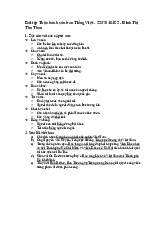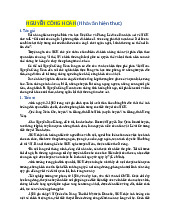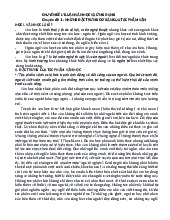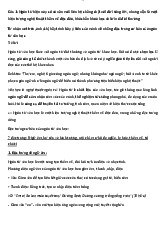











Preview text:
Unit RECIPES AND EATING HABITS 7 PART 1: GRAMMAR REVIEW I. SOME AND ANY
- SOME và ANY là hai tính từ chỉ số lượng bất định. Chúng được dùng trước danh từ
không đếm được hoặc danh từ đếm được số nhiều.
1. SOME (MỘT VÀI, MỘT ÍT) 2. ANY (NÀO)
- Some được dùng trong câu khẳng định và - Any được dùng trong câu phủ định hoặc câu lời mời, yêu cầu hỏi.
Ex: Would you like some tea? (Bạn dùng một
Ex: Do you have any pens? (Bạn có chiếc bút ít trà nhé?) nào không?)
- Some đứng trước danh từ không đếm được - Any đứng trước danh từ không đếm được
hoặc danh từ đếm được số nhiều.
hoặc danh từ đếm được số nhiều. Ex: Ex:
There isn’t any butter. (Không có chút bơ nào
There are some butter. (Có một chút bơ) cả.)
There are some eggs. (Có một vài quả trứng)
Are there any eggs? (Có quả trứng nào không?)
II. MODAL VERBS IN CONDITIONAL SENTENCES TYPE 1
Động từ khuyết thiếu trong câu điều kiện loại 1.
If - clause (Mệnh đề If)
Main clause (Mệnh đề chính)
If + S + V (present simple)
S + will/ can/ may/ must + V (bare infinitive)
Câu điều kiện này điều kiện có thể hoặc không thể thực hiện trong tương lai. Ex:
I will buy a big house if I have enough money.
I will be late for school if you don’t drive faster.
If he wants to pass the exam, he must study harder. PART 2: PRACTICE A. PHONETICS AND PHONOLOGY
I. Find the word which has a different sound in the underlined part. 1. A. tender B. garnish C. drain D. sprinkle 2. A. grill B. garnish C. dip D. slice 3. A. head B. spread C. cream D. bread 4. A. sauce B. steam C. sugar D. stew 5. A. marinate B. grate C. shallot D. staple
II. Choose the word which has a different stress pattern from the others. 1. A. tomato B. nutritious C. ingredient D. tablespoon 2. A. ingredient B. traditional C. repeat D. avocado 3. A. celery B. benefit C. engineer D. versatile 4. A. tender B. simmer C. cucumber D. delicious 5. A. significant B. diverse C. garnish D. combine B. VOCABUALRY AND GRAMMAR
I. Complete the sentences with or a, an, some . any 1. There is banana in the basket. 2. I need tea. 3. Are there tomatoes in the fridge? 4. We have
rice, but we don’t have meat. 5. There’s orange on the table. 6. I’d like apple juice. 7. He has TV and computer. 8. Would you like ice- cream? 9. I have friends in Hue. 10. Do you have dogs or cats at home?
II. Put the verbs in brackets into the correct tenses of the conditionals. 1. If you (not go)
away I’ll send for the police.
2. I’ll be very angry if he (make) any more mistakes. 3. If he (be) late we’ll go without him.
4. She will be absolutely furious if she (hear) about this. 5. If you put on the kettle I (make) the tea.
6. If you give my dog a bone he (bury) it at once.
7. If we leave the car here it (not be) in anybody’s way.
8. He’ll be late for the train if he (not start) at once.
9. If you come late they (not let) you in. 10. If he (go)
on telling lies nobody will believe a word he says.
III.Use the word given in capitals at the end of each line to form a word that fits in the gap in the same line.
All over the world, all different cultures created interesting (1) PROCESSION
meat products, and one of the most popular is undoubtedly sausage.
To begin with, sausage making may be considered (2) DISGUST
as it deals with using various animal parts. Since meat is ground up, certain
cuts and parts of an animal that wouldn’t be (3) in their original
forms can be used. Literally, this means animal parts such as noses, ears, and SERVANT other less (4)
areas of an animal’s body. Very often, the
ground up meat and flesh is (5) with a certain APPETIZE
percentage of fat, along with spices and other fillers. After being mixed well, MIXE
this meat mixture is then stuffed into the cleaned intestines of the animal,
which are then sealed at both ends. The result is sausage.
The meats used in sausages come from a variety of animals, although
beef and pork are by far the favourites. In some cultures, sausage (6)
from the meat of horses is considered a (7) . When
sausages are cooked, the cooking process sometimes adds to the flavour. MAKE While (8)
boiling is probably the simplest method, smoking DELICIOUS
sausages will add a lot of flavour.
Next time you bite into a sausage, it is probably (9)
not to think too much about how it became the (10) thing SMOKE
you are eating. After all, you don’t want to ruin a good snack. GOOD TASTE
IV. Choose the best answer A, B, C or D to complete the sentences. 1. Some of famous
in Southern Viet Nam are Hu Tieu Nam Vang, Bun Mam,
fried rice, flour cake, and many kinds of puddings. A. stapes B. ingredients C. foods D. dishes 2. Beet greens are the most
part of the vegetable and can be cooked like any other dark leafy green. A. traditional B. careful C. colourful D. nutritious 3. It is boring here. ever happens in this place. A. Anything B. Something C. Things D. Nothing 4. Moderation doesn’t mean the foods you love. A. to prevent B. preventing C. to eliminate D. eliminating
5. You should eat more fruits and vegetables if you to lose weight. A. would want B. wanted C. will want D. want
6. When we were on holiday, we spend too money. A. a lot of B. many C. much D. lots of
7. If people work so much, they depressed and eat more. A. may feel B. may have felt C. felt D. had felt 8. Studies suggest
only when you are most active and giving your digestive system a long break each day. A. eating B. being eating C. to eat D. being eaten
9. Despite the differences in cuisine of each region, there are similarities, such as the
for main meals – rice, ways of adding fish sauce, herbs and other flavors. A. foundation B. necessity C. staple D. basic
10. Perhaps the three most popular ice cream are vanilla, chocolate and strawberry. A. offers B. flavours C. brands D. ingredients 11. I spend my spare time gardening. A. most B. the most of C. most of D. most of the
12. Your body uses calcium to build healthy bones and teeth, them strong as you age. A. continue B. keep C. remain D. care
13. Food in Northern Vietnam is not as
as that in Central and Southern Viet Nam,
as black pepper is often used rather than chilies. A. spicy B. exciting C. strong D. flavour
14. Pumpkin soup is a good source of minerals and vitamins, especially vitamin A. A. fibers B. fats C. sugars D. solids 15. There’s
use in complaining. They probably won’t do anything about it. A. a few B. a little C. no D. some
16. If you eat too quickly, you may not
attention to whether your hunger is satisfied. A. keep B. show C. pay D. take
17. Another feature in northern cuisine is in winter all family members gather around a big hotpot
there is a combination of seasoned broth, vegetables and meats. A. what B. where C. which D. in which 18. You
chicken. You cook it in an oven or over a fire without liquid. A. fry B. roast C. steam D. boil 19.
cups of coffee have you taken? A. How many B. How much C. How D. How far
20. Common eating habits that can lead to
are: eating too fast, eating when not
hungry, eating while standing up, and skipping meals. A. put on weight B. be heavy C. gain weight D. weight gain
V. Identify the one underlined word or phrase that must be changed to make the sentence correct.
1. If someone came into the store, smile and say, “May I help you?” A B C D
2. If you try these cosmetics, you look five years younger. A B C D
3. If you do not understand what were written in the book, you could ask Mr. Pike. A B C D
4. I will come to meet Mr. Pike and tell him about your problems if you didn’t solve them A B C D yourself.
5. Sam will not graduate unless he doesn’t pass all the tests. A B C D
6. If there isn’t enough food, we couldn’t continue our journey. A B C D
7. Unless you pour oil on water, it will float. A B C D
8. You have to take a taxi home if you want to leave now. A B C D
9. If anyone will phone, tell them I’ll be back at 11:00. A B C D
10. We can hire a minibus if there will be enough people. A B C D C. READING
I. Fill each of the numbered blanks in the following passage. Use only one word in each space. Aboriginal barbecues recipes cookery espresso food bush meat cooking emu
Australia is a huge country and it has a lot of different kinds of (1) . In the
past, the Aboriginal people of Australia ate animals like crocodiles and some insects like the
witchetty grub. Aboriginal Australians travelled around the Australian countryside, or ‘bush’, to find food.
When the first British and Irish people moved to Australia in the 1830s, they brought sheep
and cows from Europe. They also brought traditional English and Irish recipes. Many of these (2)
, like fish and chips and (3)
pies, are still popular today. They
also created new Australian recipes such as the pavlova (a fruit dessert - named after a Russian
dancer) and damper (a bread cooked in the bush).
After 1945, a lot of people came to live in Australia from countries like Italy, Germany,
Greece, Thailand and India. They brought recipes with them and Australians began to eat and
drink different things. People started to drink (4) coffee and eat Mediterranean and Asian food.
A lot of modern Australians love (5)
with fresh food. They often cook food on (6)
in their gardens or on the beach. Today more people also eat (7) food like kangaroo and (8)
. Mark Olive, an Aboriginal chef, has a popular TV (9)
programme about traditional; (10) food. There
are always new recipes to try in Australia!
II. Choose the word or phrase among A, B, c or D that best fits the blank space in the following passage.
Humans have a long history of eating insects, and it turns out that they can be a very (1)
part of a person’s regular (2)
. Insects have a lot of protein, and
they are often easier to catch than (3)
animals. Therefore, it is no wonder that when our ancient (4)
saw some tasty worms or grabs wiggling on the ground,
they made a quick snack of them.
In Thailand, insects are a regular part of the street food that can be found. The different (5)
that people snack on are crickets, grasshoppers, giant water bugs, and assorted
worms. They are often deep-fried and salted, so they have a crunchy texture that makes them a
perfect snack food. If you can get past the (6)
that you are eating a cricket, it will
crunch in your mouth just like a corn chip!
For a lot of people, however, it is difficult to get (7) the fear of eating insects.
People tend to see insects as invaders, especially when they are crawling on the food that we are about to ear. (8)
being able to eat insects (9) feeling disgusted is
cultural. Some people cannot eat French cheese or stinky tofu because they weren’t brought up
doing so. To many of us, insects fail right into that category, making it difficult to even try them. If (10)
the chance, though, be courageous, insects can be nutritious and tasty, so
long as you can get over the “yuck” factor. 1. A. nutrition B. nutritious C. nutritions D. nutritiously 2. A. health B. fitness C. diet D. balance 3. A. prey B. pray C. eat D. digest 4. A. acquaints B. relatives C. ancestors D. offspring 5. A. insects B. animals C. herbs D. cattle 6. A. true B. exact C. fact D. reality 7. A. up B. over C. down D. on 8. A. However B. Although C. Meanwhile D. Therefore 9. A. without B. in C. far D. on 10. A. giving B. gives C. gave D. given
III.Fill in the blank with a suitable word.
Isn’t it amazing how much time we spend (1) about food? “Have you ever
eaten ...?” “What did you have for lunch?” and so on. And when you travel from one country to
another, you find that people have quite different (2) about food. People
often feel that what they eat is normal, and that what other people eat is strange or silly.
In most parts of Asia, for example, no (3) is complete without rice. In England, people (4)
potatoes every day. In the Middle East, bread is the main part of
every meal. Eating, like so many things we do, becomes a (5) which is difficult to
change. Americans like to drink a lot of orange juice and coffee. The English (6) tea
four or five times every day. Australians drink large amount of beer and the French drink (7) every day.
The sort of meat people like to eat also differs from one country to another. Horse (8)
is thought to be delicious in France. In Hong Kong, some people enjoy eating snakes.
New Zealanders eat sheep, but they never eat goat meat. The Japanese don’t like to eat sheep
meat because of its smell, but they enjoy raw fish. So it (9)
that although eating is a topic that we can talk about for hours, there is very little (10)
sense in what we say about it. People everywhere enjoy eating
what they have always been earing, and there is very little we can do to change our eating habits. D. WRITING
I. Complete the second sentence in each pair so that it has similar meaning to the first sentence, using “you”.
1. Vegetarians don’t eat meat.
=> If you’re a vegetarian, _____________________________________________
2. People who live in a cold country don t like hot weather.
=> If you live_______________________________________________________
3. Teachers have to work very hard.
=> If you’re a teacher, ________________________________________________
4. People who do a lot of exercise stay fit and healthy.
=> If you___________________________________________________________
5. Mechanics understand engines.
=> If you’re a_______________________________________________________
6. People who read newspapers know what’s happening in the world.
=> If you __________________________________________________________
II. Complete the second sentence in each pair so that it has similar meaning to the first sentence.
1. Eating healthy foods is very important.
=> It is________________________________________________________________________
2. I suggest having spaghetti and pizza tonight.
=> Let’s_______________________________________________________________________
3. You need to peel the onion and slice it.
=> The onion___________________________________________________________________
4. Follow these safety instructions or you may get burnt.
=> If you_______________________________________________________________________
5. My aunt has never tasted sushi before.
=> This is______________________________________________________________________ PART 3: TEST YOURSELF
I. Choose a word in each line that has different stress pattern. 1. A. ingredient B. cucumber C. particular D. analysis 2. A. understand B. librarian C. experiment D. historical 3. A. business B. combine C. endangered D. reduce 4. A. accidental B. outnumber C. opinion D. nutritious 5. A. pancake B. canteen C. teaspoon D. cabbage
II. Choose the best answer A, B, C or D to complete the sentences.
1. A meal of Hue people has a natural combination between flavors and colors of dishes, which creates the unique in the regional cuisine. A. description B. list C. feature D. part 2. You usually
vegetables like onion. It means that you cut them into many small pieces. A. grate B. sprinkle C. chop D. whisk 3. has left a bicycle outside. A. Anyone B. Anything C. Someone D. Something 4. Keeping a
for a few days will help you discover your bad eating habits. A. food dairy B. report C. diary D. personal
5. One special feature of cuisine in Southern Vietnam is short cooking time which aims to the freshness of food. A. remain B. exist C. stay D. continue 6. Is there
apple juice in the fridge, Quang? A. any B. some C. an D. a 7.
don’t visit this part of the town. A. The most tourists B. Most of tourists C. Most tourists D. Most the tourists
8. You may have had certain eating habits for so long that you do not they are unhealthy. A. understand B. tell C. recognize D. realize
9. If children don’t play sports, they sleepy and tired. A. would have felt B. had felt C. would feel D. will feel
10. If I feel hungry in the afternoon, I snacks like fresh carrots. A. had had B. might have C. would have D. had
11. Can I have a pizza, a dozen eggs and a of lemonade, please? A. piece B. tub C. bottle D. jar 12. I think that
lemon juice on fish makes it taste better. A. few B. a few C. little D. a little
13. If parents don’t cook at home, their children more fast food. A. may have B. had had C. have D. would have
14. If my mother goes home late this evening, my father . A. had cooked B. has cooked C. will cook D. would cook 15. I would like a of broccoli and two carrots. A. slice B. head C. bunch D. clove
16. We couldn’t buy anything because of the shops were open. A. all B. half C. most D. none
17. If you eat a lot of fruit, you health problems. A. had B. will never have C. have D. may have 18. Such
as sugar, sugarcane, and coconut water are mostly used in Southern
Vietnamese food than in Northern and Central Viet Nam. A. ingredients B. menus C. dishes D. courses
19. I didn’t eat everything that they me at the party. A. served B. shared C. cooked D. baked
20. The village is very small. There are houses. A. a few B. only a few C. some D. only a little
III.Choose the word in the box to complete the text. sophisticatedly livestock ingredients characterized cuisine influence shrimps dishes flavors varies Vietnamese food culture (1)
by regions from the north to the south. In
Northern Viet Nam, Vietnamese food is (2)
by light and balanced flavours with the combination of many (3)
Northerners have been using many kinds of meats
like pork, beef, and chicken to cook; besides, some kinds of freshwater fish, crustaceans, and other mollusks like (4)
, crabs, and oysters, etc. Many famous dishes of Viet Nam
are cooked with these ingredients such as Bun Rieu, Pho, Bun Thang, Bun Cha, Banh Cuon, etc.
Then food culture in Central and Southern Viet Nam has developed suitable (5)
in each region. In Central Viet Nam, the regional cuisine of Central Viet Nam is
famous for its spicy food, which differs from two other parts with mostly non-spicy food. Hue
cuisine is typical Central Viet Nam’s food culture. (6) of Hue cuisine are decorative
and colorful, which expresses the influence of the Vietnamese royal (7) in the
feudal period. Food in the region is often decorated (8) and used with chili peppers
and shrimp sauces, namely, Bun Bo Hue, Banh xeo, or Banh beo, etc.
In Southern Viet Nam, the region is characterized by warm weather and fertile soil, which
creates favorable conditions for planting a variety of fruit, vegetables and (9)
. Thus, food in the region is often added with garlic, shallots and fresh herbs. Particularly,
Southerners are favored of sugar; they add sugar in most dishes. Here, there is also an (10)
of western and Asian cuisines on southern food, such as influences from
China, India, France, and Thailand.
IV. Fill in the blank with a suitable word. Many health (1)
believe that children and young people today are more (2)
than they used to be. So why has this happened?
One reason is bad eating habits. (3)
of young people don’t have a healthy diet.
They eat too much fast food (4)
hamburgers and pizza and not enough fruit and
vegetables. In the US, many children have been eating fast food (5) since they
were very young. In fact, almost one-third of American children aged four to nineteen have been eating fast food (6)
all the time. They also don’t (7) exercise and spend too (8)
of their time watching TV, surfing the Internet or playing computer games.
So how can you change your habits if you have been following an unhealthy lifestyle for
a long time? First, change your (9)
and eat more fruit and vegetables. Next, find
an activity you enjoy. Why not try something different like rock climbing, surfing or hiking?
Many young people have found that (10)
fit and healthy can be a lot of fun.
V. Complete the sentences with or a, an, some . any 1. I don’t have paper. 2. Is there petrol in the car? 3. I buy fruits, but I don’t have vegetables. 4. Do you have stamps? I need two. 5. I need butter to make a cake. 6. I don’t have free time today. Sorry. 7. Are there potatoes in the basket? 8. There is ink-pot on the table. 9. Can I have glass of milk? 10. Thank you. And
box of chocolates would be fine.
VI. Fill in the blanks with: much/ many/ few/ little/ most.
1. She isn’t very popular. She has friends.
2. Ann is very busy these days. She has free time. 3. Did you take
photographs when you were on holiday?




